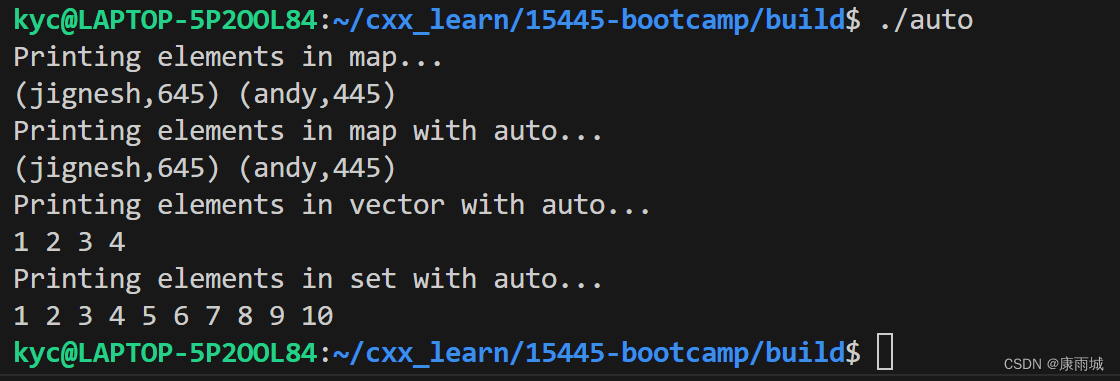本文主要是介绍【cmu15445c++入门】(7)C++ auto 关键字,希望对大家解决编程问题提供一定的参考价值,需要的开发者们随着小编来一起学习吧!
一、auto关键字介绍
C++ auto 关键字是一个关键字,它告诉编译器通过其初始化表达式推断声明变量的类型。它可以提高开发人员的效率(开发人员不再需要输入冗长、不守规矩的类型名称)。它在 for-each 循环的上下文中也很有用。但是,使用 auto 会带来风险,因为开发人员可能不知道他们正在使用的类型,因此存在错误和非功能性代码的风险。所以要小心!
二、代码
// Includes std::cout (printing) for demo purposes.
#include <iostream>
// Includes the std::set library.
#include <set>
// Includes the C++ string library.
#include <string>
// Includes the std::vector library.
#include <vector>
// Includes the std::unordered map library.
#include <unordered_map>// The C++ auto keyword is a keyword that tells the compiler to infer the type
// of a declared variable via its initialization expression. It can be
// incredibly useful, as it allows for developer efficiency (where the developer
// no longer has to type out long, unruly type names). It is also useful in the
// context of for-each loops. However, using auto poses a risk where the
// developer may not be aware of the types they are using, and therefore at risk
// for buggy and non functional code. So be careful!// C++ auto 关键字是一个关键字,它告诉编译器通过其初始化表达式推断声明变量的类型。
// 它可以提高开发人员的效率(开发人员不再需要输入冗长、不守规矩的类型名称)。
// 它在 for-each 循环的上下文中也很有用。
// 但是,使用 auto 会带来风险,因为开发人员可能不知道他们正在使用的类型.
// 因此存在错误和非功能性代码的风险。所以要小心!// Basic templated class with very long name, to show the usefulness of auto.
template <typename T, typename U> class Abcdefghijklmnopqrstuvwxyz {
public:Abcdefghijklmnopqrstuvwxyz(T instance1, U instance2): instance1_(instance1), instance2_(instance2) {}void print() const {std::cout << "(" << instance1_ << "," << instance2_ << ")\n";}private:T instance1_;U instance2_;
};// Templated function that returns an object of this class with a very long
// name.
template <typename T>
Abcdefghijklmnopqrstuvwxyz<T, T> construct_obj(T instance) {return Abcdefghijklmnopqrstuvwxyz<T, T>(instance, instance);
}int main() {// The auto keyword is used to initialize the variable a. Here, the type// is inferred to be type int.auto a = 1;// Here are more examples of using auto to declare basic variables.// Depending on the IDE being used, it might say what types a, b, and c// are.auto b = 3.2;auto c = std::string("Hello");// auto is not particularly useful for these prior examples. As one can// see, typing int a = 1;, float b = 3.2;, and std::string c = "Hello";// does not take significant overhead. However, there will definitely// be cases where the type name is long and complicated, or when the// type name is heavily templated, and using auto may be helpful.Abcdefghijklmnopqrstuvwxyz<int, int> obj = construct_obj<int>(2);auto obj1 = construct_obj<int>(2);// Maybe for one line it does not seem all that convenient, but imagine// if using a class with a very long name was useful in the code for// an extended period of time. Then, I'd imagine it would save a lot of// typing time!// 也许对于一行来说,它似乎并不那么方便,但想象一下,如果使用一个名称很长的类在代码中很长一段时间内都很有用。然后,我想它会节省很多打字时间!// One important thing to note about the auto keyword is that it // defaults to copying objects, which can lower performance. Take the// following example where we construct a int vector, and want to// define a variable that is a reference to it.// 关于 auto 关键字需要注意的一件重要事情是,它默认用于复制对象,这可能会降低性能。// 以下面的例子为例,我们构造了一个 int 向量,并想要定义一个变量来引用它。std::vector<int> int_values = {1, 2, 3, 4};// The following code deep-copies int_values into copy_int_values,// since auto infers the type as std::vector<int>, not std::vector<int>&.// 下面的例子是个拷贝auto copy_int_values = int_values;// However, the following code defines ref_int_values, which is a reference// to int_values, and therefore does not deep copy the int_values vector.// 下面的例子是个引用auto& ref_int_values = int_values;// The auto keyword is also useful for iterating through C++ containers.// For instance, let's construct an unordered map with std::string keys// and int values, and discuss methods of iterating through it.std::unordered_map<std::string, int> map;map.insert({{"andy", 445}, {"jignesh", 645}});// One method mentioned in unordered_map.cpp was to iterate through// a map by using a for loop with an iterator. Compare the readability// of the two loops below.// 关于 auto 关键字需要注意的一件重要事情是,对于对象采用的是复制,这可能会降低性能。// 以下面的例子为例,我们构造了一个 int 向量,并想要定义一个变量来引用它。std::cout << "Printing elements in map...\n";for (std::unordered_map<std::string, int>::iterator it = map.begin();it != map.end(); ++it) {std::cout << "(" << it->first << "," << it->second << ")"<< " ";}std::cout << std::endl;std::cout << "Printing elements in map with auto...\n";for (auto it = map.begin(); it != map.end(); ++it) {std::cout << "(" << it->first << "," << it->second << ")"<< " ";}std::cout << std::endl;// It is also possible to use the auto keyword to iterate over vectors// and sets.std::vector<int> vec = {1, 2, 3, 4};std::cout << "Printing elements in vector with auto...\n";for (const auto& elem : vec) {std::cout << elem << " ";}std::cout << std::endl;std::set<int> set;for (int i = 1; i <= 10; ++i) {set.insert(i);}std::cout << "Printing elements in set with auto...\n";for (const auto &elem : set) {std::cout << elem << " ";}std::cout << std::endl;// Overall, auto is a useful C++ keyword that can be used to write code more// efficiently, and to write cleaner and more readable code.// Keep in mind that using auto to iterate through C++ containers is better// in practice, since it produces more readable code. However, if you're not// sure of the types that are being used, it is always okay to revert back// to figuring out the type yourself.// 总的来说,auto 是一个有用的 C++ 关键字,可用于更高效地编写代码,并编写更干净、更易读的代码。// 请记住,在实践中使用 auto 遍历 C++ 容器会更好,因为它会生成更具可读性的代码。// 但是,如果不确定正在使用的类型,则始终可以恢复到自己确定类型。return 0;
}运行结果

这篇关于【cmu15445c++入门】(7)C++ auto 关键字的文章就介绍到这儿,希望我们推荐的文章对编程师们有所帮助!







